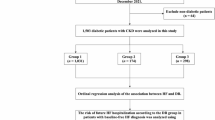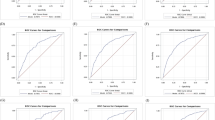Abstract
Purpose
To assess the value of diabetic retinopathy (DR) severity as a possible predictive prognostic factor for the progression of chronic kidney disease (CKD).
Patients and methods
Retrospective cohort study. Patients (51) who were initially diagnosed with DR and CKD were enrolled and their medical records were evaluated. The following ophthalmic factors were assessed by fluorescein angiography at the initial visit: area of capillary nonperfusion, presence of neovascularization and vitreous hemorrhage, and DR grade. The effect of these factors on CKD progression over the 2-year period of the study, defined as doubling of serum creatinine or the development of end-stage renal disease requiring dialysis or renal transplant, was evaluated.
Results
The study included 51 patients with DR and CKD; of these, 11 patients (21.6%) were found to have proliferative DR (PDR) and seven patients (13.7%) had high-risk PDR at baseline. Patients with ischemic DR, who showed extensive capillary nonperfusion (≥10 optic disc areas) in the retina, had a greater risk for CKD progression (hazard ratio=6.64; P=0.002).
Conclusion
We found that extensive capillary nonperfusion in the retina greatly increased the risk of progression of CKD in patients with DR. This suggests that the retina and the kidney may have shared risk factors for microvascular disease secondary to diabetes mellitus, and emphasizes the need for a team approach to diabetes care.
Similar content being viewed by others
Log in or create a free account to read this content
Gain free access to this article, as well as selected content from this journal and more on nature.com
or
References
Foley RN, Collins AJ . End-stage renal disease in the United States: an update from the United States Renal Data System. J Am Soc Nephrol 2007; 18: 2644–2648.
Go AS, Chertow GM, Fan D, McCulloch CE, Hsu CY . Chronic kidney disease and the risks of death, cardiovascular events, and hospitalization. N Engl J Med 2004; 351: 1296–1305.
Schiffrin EL, Lipman ML, Mann JF . Chronic kidney disease: effects on the cardiovascular system. Circulation 2007; 116: 85–97.
Keane WF, Brenner BM, de Zeeuw D, Grunfeld JP, McGill J, Mitch WE et al. The risk of developing end-stage renal disease in patients with type 2 diabetes and nephropathy: the RENAAL study. Kidney Int 2003; 63: 1499–1507.
Wild S, Roglic G, Green A, Sicree R, King H . Global prevalence of diabetes: estimates for the year 2000 and projections for 2030. Diabetes Care 2004; 27: 1047–1053.
Girach A, Vignati L . Diabetic microvascular complications—can the presence of one predict the development of another? J Diabetes Complications 2006; 20: 228–237.
El-Asrar AM, Al-Rubeaan KA, Al-Amro SA, Moharram OA, Kangave D . Retinopathy as a predictor of other diabetic complications. Int Ophthalmol 2001; 24: 1–11.
Karlberg C, Falk C, Green A, Sjølie AK, Grauslund J . Proliferative retinopathy predicts nephropathy: a 25-year follow-up study of type 1 diabetic patients. Acta Diabetologica 2012; 49: 263–268.
Pedro RA, Ramon SA, Marc BB, Juan FB, Isabel MM . Prevalence and relationship between diabetic retinopathy and nephropathy, and its risk factors in the North-East of Spain, a population-based study. Ophthalmic Epidemiol 2010; 17: 251–265.
Romero P, Salvat M, Fernández J, Baget M, Martinez I . Renal and retinal microangiopathy after 15 years of follow-up study in a sample of type 1 diabetes mellitus patients. J Diabetes Complications 2007; 21: 93–100.
Grunwald JE, Alexander J, Ying GS, Maguire M, Daniel E, Whittock-Martin R et al. Retinopathy and chronic kidney disease in the Chronic Renal Insufficiency Cohort (CRIC) study. Arch Ophthalmol 2012; 130 (9): 1136–1144.
Foundation NK . K/DOQI clinical practice guidelines for chronic kidney disease: evaluation, classification, and stratification. Am J Kidney Dis 2002; 39: S1–266.
Kobayashi M, Hirawa N, Morita S, Yatsu K, Kobayashi Y, Yamamoto Y et al. Silent brain infarction and rapid decline of kidney function in patients with CKD: a prospective cohort study. Am J Kidney Dis 2010; 56: 468–476.
Matsuo S, Imai E, Horio M, Yasuda Y, Tomita K, Nitta K et al. Revised equations for estimated GFR from serum creatinine in Japan. Am J Kidney Dis 2009; 53: 982–992.
Vervoort G, Willems HL, Wetzels JF . Assessment of glomerular filtration rate in healthy subjects and normoalbuminuric diabetic patients: validity of a new (MDRD) prediction equation. Nephrol Dial Transplant 2002; 17: 1909–1913.
Patel SS, Kimmel PL, Singh A . New clinical practice guidelines for chronic kidney disease: a framework for K/DOQI. Semin Nephrol 2002; 22: 449–458.
American Diabetes Association. Report of the expert committee on the diagnosis and classification of diabetes mellitus. Diabetes Care. 1997; 20: 1183–1201.
Diabetic Retinopathy Study Coordinating Center. Diabetic Retinopathy Study: mannual of operations. Diabetic Retinopathy Study Coordinating Center: Baltimore, 1972.
Early Treatment Diabetic Retinopathy Study Research Group. Grading diabetic retinopathy from stereoscopic color fundus photographs: an extension of the modified Airlie House classification. ETDRS report number 10. Ophthalmology 1991; 98 (5 Suppl): 786–806.
Klein R, Klein BE, Moss SE, Cruickshanks KJ . The Wisconsin Epidemiologic Study Of Diabetic Retinopathy. XIV. Ten-year incidence and progression of diabetic retinopathy. Arch Ophthalmol 1994; 112: 1217–1228.
Klein R, Klein BE, Moss SE, Cruickshanks KJ . The Wisconsin Epidemiologic Study of Diabetic Retinopathy: XVII. The 14-year incidence and progression of diabetic retinopathy and associated risk factors in type 1 diabetes. Ophthalmology 1998; 105: 1801–1815.
Snyder S, Pendergraph B . Detection and evaluation of chronic kidney disease. Am Fam Physician 2005; 72: 1723–1732.
Baseline and early natural history report. The Central Vein Occlusion Study. Arch Ophthalmol 1993; 111: 1087–1095.
Mahurkar AA, Vivino MA, Trus BL, Kuehl EM, Datiles MB 3rd, Kaiser-Kupfer MI . Constructing retinal fundus photomontages. a new computer-based method. Invest Ophthalmol Vis Sci 1996; 37: 1675–1683.
Author information
Authors and Affiliations
Corresponding author
Ethics declarations
Competing interests
The authors declare no conflict of interest.
Additional information
Author contributions
HYC had full access to the data in the study and takes responsibility for the integrity of the data and the accuracy of the data analysis.
Supplementary Information accompanies this paper on Eye website
Supplementary information
Rights and permissions
About this article
Cite this article
Lee, W., Sobrin, L., Kang, M. et al. Ischemic diabetic retinopathy as a possible prognostic factor for chronic kidney disease progression. Eye 28, 1119–1125 (2014). https://doi.org/10.1038/eye.2014.130
Received:
Accepted:
Published:
Issue date:
DOI: https://doi.org/10.1038/eye.2014.130
This article is cited by
-
Is diabetic retinopathy affected by diabetes type? A retrospective study using electronic medical record data from patients with latent autoimmune diabetes in adults, type 1 diabetes, and type 2 diabetes
Acta Diabetologica (2021)
-
Statement of the German Ophthalmological Society, the German Retina Society, and the Professional Association of Ophthalmologists in Germany on treatment of diabetic macular edema
Der Ophthalmologe (2021)
-
Risk factors for retinopathy in hemodialysis patients with type 2 diabetes mellitus
Scientific Reports (2020)
-
Stellungnahme der DOG, der RG und des BVA zur Therapie des diabetischen Makulaödems
Der Ophthalmologe (2020)
-
Relationships between vitreous levels of soluble receptor for advanced glycation end products (sRAGE) and renal function in patients with diabetic retinopathy
International Ophthalmology (2017)



